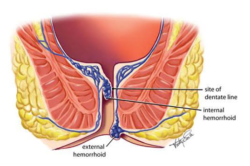
Internal Hemorrhoids: Symptoms and Effective Treatment Options
Internal hemorrhoids are a common but often not talked about condition affecting millions of people. They arise from swelling in the blood vessels and soft tissue within the rectum, leading to a range of symptoms that can include painless bleeding during bowel movements, itching, and discomfort. Effective treatment options vary depending on the severity of the symptoms and can range from lifestyle adjustments and home remedies to medical procedures. In this section, we will delve into the symptoms to look out for and the various treatments that can help alleviate this uncomfortable condition.
Internal hemorrhoids are swollen veins inside the rectum and are not visible from outside the anus. Unlike external hemorrhoids, they are typically less painful due to the lack of pain-sensing nerves in the rectum. However, they can still cause discomfort and lead to complications if left untreated. Understanding the symptoms and available treatments is crucial for managing this common condition.
Symptoms of Internal Hemorrhoids
The symptoms of internal hemorrhoids can vary, depending on their severity (graded from I to IV). Common signs include:
- Painless Bleeding: One of the most noticeable signs is painless bleeding during bowel movements. You might observe small amounts of bright red blood on your toilet tissue or in the toilet bowl.
- Protrusion During Bowel Movements: In more advanced cases, the hemorrhoid may protrude through the anal opening during bowel movements, known as prolapse, which may retract on its own or need to be pushed back in manually.
- Discomfort or Itching: Excess moisture from the protrusion can lead to anal itching or discomfort.
- Mucus Discharge: A mucus discharge, leading to a feeling of not having fully emptied the bowels after a bowel movement, can occur.
Treatment Options for Internal Hemorrhoids
The treatment for internal hemorrhoids often depends on the severity of the symptoms and the grade of the hemorrhoid. Options range from home remedies and lifestyle changes to more advanced medical procedures:
Lifestyle Changes and Home Remedies:
- Dietary Fiber: Increasing dietary fiber intake through fruits, vegetables, whole grains, and legumes can soften stools and reduce the strain during bowel movements, alleviating symptoms.
- Hydration: Drinking plenty of water helps prevent constipation, reducing the need for straining.
- Sitz Baths: Sitting in warm water for 10 to 15 minutes several times a day, especially after bowel movements, can relieve discomfort.
Medications:
- Over-the-counter (OTC) Treatments: OTC creams and suppositories designed for hemorrhoid relief can temporarily soothe pain, itching, and swelling.
Minimally Invasive Procedures (often for more persistent or severe hemorrhoids):
- Rubber Band Ligation: A small rubber band is placed around the base of the hemorrhoid to cut off its blood supply, causing it to wither and fall off within a week.
- Sclerotherapy: A chemical solution is injected into the hemorrhoid tissue to shrink it.
- Infrared Coagulation: Infrared light is used to heat and scar the hemorrhoid tissue, reducing blood flow to the hemorrhoids and causing them to shrink.
Surgery:
- Hemorrhoidectomy: Surgical removal of severe hemorrhoids is the most effective and complete way to treat severe or recurrent hemorrhoids but comes with a longer recovery period.
- Stapled Hemorrhoidopexy: A less painful alternative to traditional hemorrhoidectomy, this procedure involves using a surgical stapler to remove hemorrhoidal tissue and reposition the remaining tissue back to its normal location. It's typically used for prolapsed hemorrhoids.
Preventive Measures and Lifestyle Management for Internal Hemorrhoids
Preventing the occurrence or recurrence of internal hemorrhoids largely hinges on lifestyle and dietary modifications. A diet high in fiber is critical for softening stools and minimizing the strain during bowel movements—key factors in reducing the risk of hemorrhoids developing or exacerbating. Regular exercise is also vital as it helps maintain bowel regularity and prevents constipation. Additionally, managing body weight to avoid the increase in abdominal pressure can be beneficial, along with avoiding prolonged sitting, particularly on the toilet, as this can increase pressure in the anal veins.
Conclusion
Internal hemorrhoids, while less painful than their external counterparts, can cause significant discomfort and lead to complications like anemia from chronic blood loss if not managed properly. Early intervention with lifestyle changes and home remedies is often effective, but persistent or severe cases may require medical or surgical treatment. If you experience symptoms of internal hemorrhoids, especially bleeding, it's important to consult a healthcare provider to rule out more serious conditions and discuss the most appropriate treatment options for your situation.
